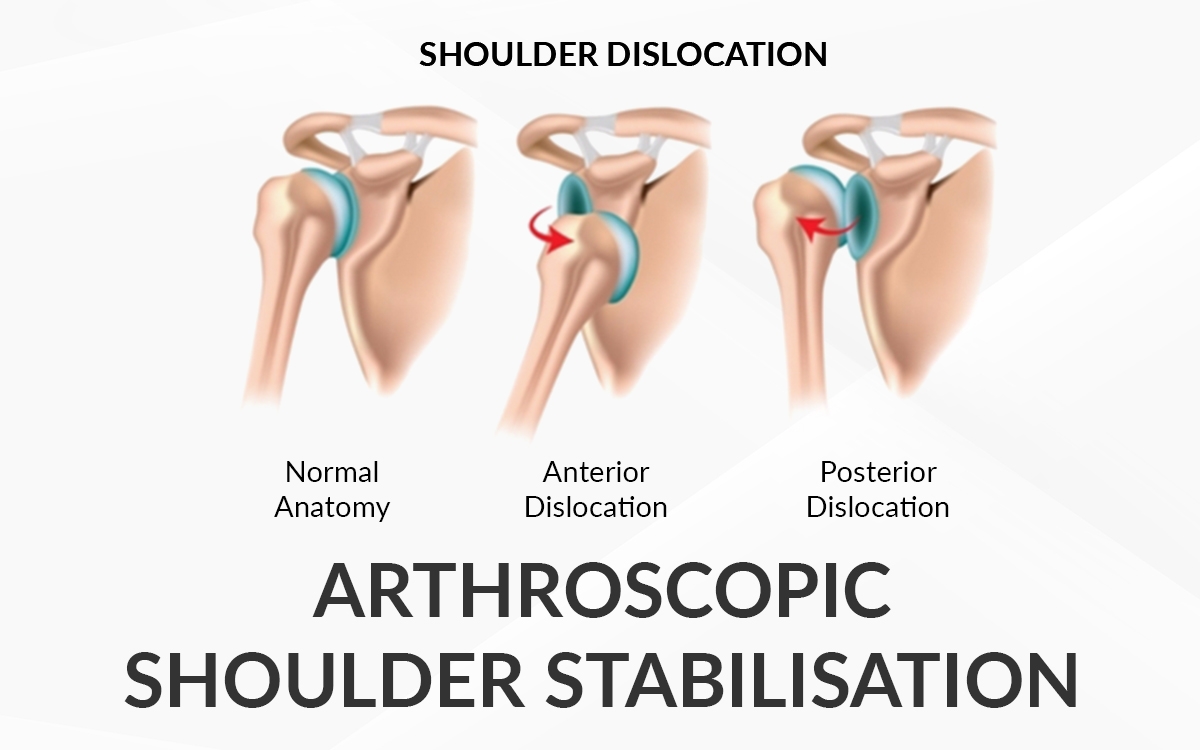
Summary
Surgery involves
- Repairing the overstretched / torn labrum or capsule deep within the shoulder joint
Why Shoulder Stabilisation?
- Prevent further dislocation and to prevent further damage to the soft tissues, especially in the front of the shoulder
When is surgery essential?
- If the damage to bone or soft tissue is more or physiotherapy doesn’t work
What is an Arthroscopic Shoulder Stabilisation?
The shoulder is the most mobile joint in the body. It can easily become unstable i.e. no longer be held in place firmly and dislocate after a sports injury or an accident. Unfortunately when a shoulder dislocates anteriorly, the surrounding structures, especially the structures in the front of the shoulder can get damaged. If the shoulder does not heal properly then it will become susceptible to further dislocations, sometimes after only a minor injury.
Arthroscopic stabilisation (Bankart Repair) procedure involves repairing the overstretched / torn labrum and capsule deep within the shoulder joint. Preference is to perform this surgery arthroscopically (keyhole) but some surgeons prefer an open procedure. During this procedure, an arthroscope (camera) is inserted into the shoulder to visualise the shoulder joint and the surrounding structures. Fluid (saline) is passed into the shoulder to help with visualisation. The damaged labrum and capsule is then repaired and tightened to restore stability to the joint. It is usually done using sutures and small bone anchors.
Arthroscope (camera) is inserted through a small skin incision from the back of the shoulder and special instruments are inserted through the front of the shoulder. In total there will be around three 5- 10 mm puncture wounds.
What are the benefits of having an Arthroscopic Shoulder Stabilisation?
The main benefit is to prevent further dislocation and to prevent further damage to the soft tissues, especially in the front of the shoulder. Once the stability to your shoulder is restored you should be able to do more in terms of your daily activities or sports activities.
What are the complications?
In authors experience it is a very safe procedure with predictable results. Overall the complication rate is around 3-4% which includes infection, damage to nerves, bleeding, blood clots, stiffness to the shoulder and re-dislocation which can affect 4-5 shoulders out of 100 patients treated.
Are there any alternatives to surgery?
Depending on the amount of damage to the soft tissues and bone, we can try a course of physiotherapy where the rotator cuff muscles are strengthened. If the damage to bone or soft tissue is more or physiotherapy doesn’t work then an operation becomes essential to help repair the capsule or labrum.
What happens during the operation?
On the day of your surgery you will be seen by the surgeon and the anaesthetist who will discuss the procedure, take consent from you and discuss post operative rehabilitation. Your surgery will be done in a beach chair position. During this procedure, an arthroscope (camera) is inserted into the shoulder to visualise the shoulder joint and the surrounding structures. Fluid (saline) is passed into the shoulder joint to help with visualisation. The damaged labrum and capsule is then repaired and tightened to restore stability to the joint. It is usually done using sutures and small bone anchors.
What happens after the surgery?
After the surgery you will be sent to the recovery room for a few hours. Once you have recovered, you will be able to go home the same day. You will need to keep the wound dressings dry for two weeks at which stage you will be seen by your consultant for a wound check and removal of stitches. You will be given a sling which you will have to wear for 4-6 weeks. You will also be seen by a physiotherapist who will teach you shoulder exercises.
How long will I be off for after shoulder arthroscopy?
As your wound takes two weeks to heal, you will be off for this duration. You will be able to do some daily activities around two to three weeks. For people who work at a desk, they will be able to resume work around three weeks’ time. If you lift, push or pull at work, you will need three to four months off. Your shoulder will improve within 9-10 months.
BMI Chelsfield Park Hospital
Bucks Cross Road Chelsfield ORPINGTON BR6 7RG
01689 877855
BMI The Blackheath Hospital
40-42 Lee Terrace Blackheath LONDON SE3 9UD
020 8318 7722
BMI The Sloane Hospital
125 Albemarle Road BECKENHAM BR3 5HS
020 8466 4000
Princess Royal University Hospital
Farnborough Common ORPINGTON BR6 8ND
01689 863223



